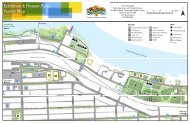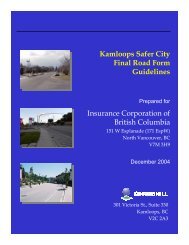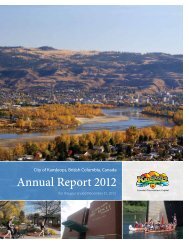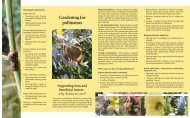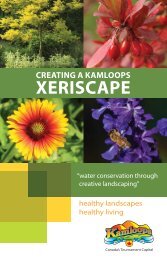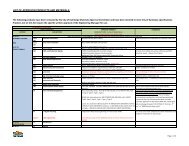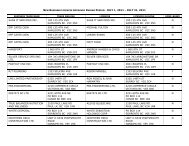Planting the seeds for a sustainable future - City of Kamloops
Planting the seeds for a sustainable future - City of Kamloops
Planting the seeds for a sustainable future - City of Kamloops
You also want an ePaper? Increase the reach of your titles
YUMPU automatically turns print PDFs into web optimized ePapers that Google loves.
AGRICULTURAL CAPABILITYFigure 3 – CLI Capability <strong>of</strong> soils in <strong>the</strong> <strong>City</strong> <strong>of</strong> <strong>Kamloops</strong> (Source: LUI)The Canada Land Inventory (CLI) is a system <strong>for</strong> classifying <strong>the</strong>agricultural capability <strong>of</strong> soils. CLI soil classes range from 1 to 7, withClasses 1 to 3 considered as prime agricultural land. Class 4 haslimitations that require special management practices or severely limit<strong>the</strong> range <strong>of</strong> crops or both. Classes 5 and 6 will essentially only produce<strong>for</strong>age (hay and pasture). Class 5-7 rangeland provides feed <strong>for</strong> cattle<strong>for</strong> six to eight months <strong>of</strong> <strong>the</strong> year. Ranchers can use <strong>the</strong>ir moreproductive lands to produce winter feed such as hay. Ranching workswell with <strong>the</strong> land base, topography, and climate in <strong>the</strong> <strong>Kamloops</strong> area.For most soils, <strong>the</strong>re is an unimproved rating and an improved rating.The capability is "improved" when <strong>the</strong> limitations are removed. In<strong>Kamloops</strong>, <strong>the</strong> main limitation is "aridity" which is removed by irrigating.Map 13 illustrates that, without irrigation, 25,678 ha (82%) <strong>of</strong> <strong>the</strong> landbase (Classes 5 and 6 combined) will only produce <strong>for</strong>age (feed <strong>for</strong> <strong>the</strong>livestock industry). With irrigation, <strong>the</strong> area <strong>of</strong> prime land (Class 1, 2and 3) increases from 1,744 ha to 10,513 ha (Map 13). Maps 13 and14 illustrate <strong>the</strong> Land Capability Classification <strong>for</strong> Agriculture based onsoil characteristics within <strong>the</strong> <strong>City</strong> (unimproved and improvedclassifications respectively). Currently, only 1,138 ha are irrigated.Number <strong>of</strong> FarmsAccording to BC Assessment (2013), 309 properties within <strong>the</strong> <strong>City</strong> <strong>of</strong><strong>Kamloops</strong> are currently classified as properties with provincial farmstatus. This status is <strong>for</strong> taxing purposes only. Local governmentsapply a tax rate to farmland which is typically lower than that <strong>for</strong> o<strong>the</strong>rland. To receive and maintain <strong>the</strong> farm classification, <strong>the</strong> land mustgenerate income from agricultural production.Minimum income requirements <strong>for</strong> Provincial FarmStatus are calculated as follows:a) $10,000 on land less than .8 hectares (2 acres);b) $2,500 on land between .8 hectares (2 acres) and4 hectares (10 acres);c) on land larger than 4 hectares (10 acres), youmust earn $2,500 plus five per cent <strong>of</strong> <strong>the</strong> actualvalue <strong>of</strong> any farm land in excess <strong>of</strong> 4 hectares.CITY OF KAMLOOPS 26




